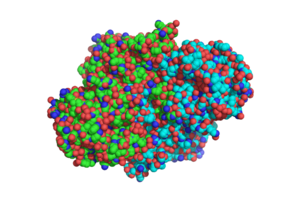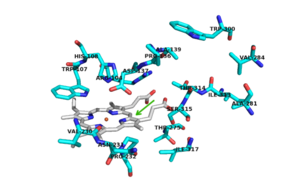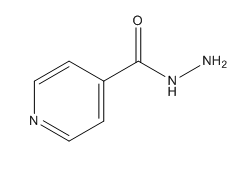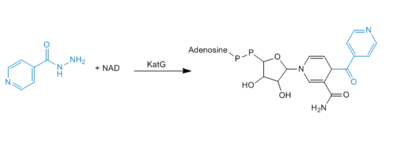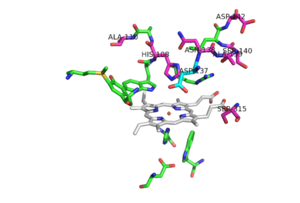Sandbox Reserved 1072
From Proteopedia
(Difference between revisions)
| Line 2: | Line 2: | ||
<StructureSection load='1SJ2' size='340' side='right' caption=' ' scene=''> | <StructureSection load='1SJ2' size='340' side='right' caption=' ' scene=''> | ||
| - | |||
| + | ==Introduction== | ||
| + | [http://en.wikipedia.org/wiki/Mycobacterium_tuberculosis ''Mycobacterium Tuberculosis''] [http://en.wikipedia.org/wiki/Catalase-peroxidase Catalase Peroxidase] (''mt''CP) is a [http://en.wikipedia.org/wiki/Protein_dimer homodimer] with each [http://en.wikipedia.org/wiki/Monomer monomer] consisting of two [http://en.wikipedia.org/wiki/Protein_domain domains]. The overall structure is stabilized by 703 water molecules. | ||
| + | |||
| + | ===Catalase Peroxidases=== | ||
| + | Catalase-peroxidases are enzymes that degrade hydrogen peroxide. Catalase converts two equivalents of hydrogen peroxide into water and oxygen via a two-step reaction cycle in which H<sub>2</sub>0<sub>2</sub> alternately oxidizes and reduces the heme iron at the active site. Within peroxidases, oxidation of heme iron involves a H<sub>2</sub>0<sub>2</sub> molecules, similar to that in the catalase-catalyzed reaction. Reduction of the heme iron, however, involves hydrogen donors such as NADH, not a second H<sub>2</sub>0<sub>2</sub> molcule (3). Catalase-Peroxidases that have been characterized are either homodimers or homotetramers and contain a single heme ''b'' cofactor at the active site. Usually, the primary struture of the subunit can be divided into two halves that have a high level of sequence similarity, most likely due to a gene duplication event. | ||
==Structure== | ==Structure== | ||
[[Image:DotSTRUCTURE.png|300 px|left|thumb|Overall structure of [http://www.rcsb.org/pdb/explore/explore.do?structureId=1sJ2 1SJ2], showing that the structure is a [http://en.wikipedia.org/wiki/Protein_dimer homodimer].]] | [[Image:DotSTRUCTURE.png|300 px|left|thumb|Overall structure of [http://www.rcsb.org/pdb/explore/explore.do?structureId=1sJ2 1SJ2], showing that the structure is a [http://en.wikipedia.org/wiki/Protein_dimer homodimer].]] | ||
| - | + | ==Structure== | |
The two [http://en.wikipedia.org/wiki/Protein_domain domains] of each monomer are primarily [http://en.wikipedia.org/wiki/Alpha_helix alpha helical] and have similar foldings. The similar foldings suggests that the monomer results from a [http://en.wikipedia.org/wiki/Gene_duplication gene duplication] event; however, the C-terminal domain does not contain the [http://en.wikipedia.org/wiki/Heme_B heme ''b''] prosthetic group, while the <scene name='69/694238/N_terminus/1'>N terminal</scene> does. The [http://en.wikipedia.org/wiki/Active_site active site] is therefore located within the N-terminal domain. The two monomers interact through an interlocking hook formed by the N-terminal domains that stabilizes the formation of the dimer (1). | The two [http://en.wikipedia.org/wiki/Protein_domain domains] of each monomer are primarily [http://en.wikipedia.org/wiki/Alpha_helix alpha helical] and have similar foldings. The similar foldings suggests that the monomer results from a [http://en.wikipedia.org/wiki/Gene_duplication gene duplication] event; however, the C-terminal domain does not contain the [http://en.wikipedia.org/wiki/Heme_B heme ''b''] prosthetic group, while the <scene name='69/694238/N_terminus/1'>N terminal</scene> does. The [http://en.wikipedia.org/wiki/Active_site active site] is therefore located within the N-terminal domain. The two monomers interact through an interlocking hook formed by the N-terminal domains that stabilizes the formation of the dimer (1). | ||
| Line 24: | Line 28: | ||
In ''hm''CP, which share 55% and 69% identity with ''mt''CP, the heme is buried inside ''Hm''CP-N, and substrate access to the active site is through a narrow channel that prevents access of a large substrate (3). The location of the binding site for [http://en.wikipedia.org/wiki/Isoniazid isoniazid (INH)] is located near the ''δ meso'' heme edge, about 3.8 Å away from the heme iron. This binding site is found within what is considered to be the usual substrate access channel of peroxidases. The reaction between INH and the enzyme must occur from interaction in a binding site intended for the natural substrate (2). Asp 137 plays a key role in the activation and binding of INH. Asp 137 creates energetically favorable interactions due to its ability to make hydrogen-bond interactions between its carboxylic acid side chain and the pyridinyl N1 of INH. | In ''hm''CP, which share 55% and 69% identity with ''mt''CP, the heme is buried inside ''Hm''CP-N, and substrate access to the active site is through a narrow channel that prevents access of a large substrate (3). The location of the binding site for [http://en.wikipedia.org/wiki/Isoniazid isoniazid (INH)] is located near the ''δ meso'' heme edge, about 3.8 Å away from the heme iron. This binding site is found within what is considered to be the usual substrate access channel of peroxidases. The reaction between INH and the enzyme must occur from interaction in a binding site intended for the natural substrate (2). Asp 137 plays a key role in the activation and binding of INH. Asp 137 creates energetically favorable interactions due to its ability to make hydrogen-bond interactions between its carboxylic acid side chain and the pyridinyl N1 of INH. | ||
| - | + | ||
| - | + | ||
==Clinical Applications== | ==Clinical Applications== | ||
Revision as of 13:14, 14 April 2015
| This Sandbox is Reserved from 02/09/2015, through 05/31/2016 for use in the course "CH462: Biochemistry 2" taught by Geoffrey C. Hoops at the Butler University. This reservation includes Sandbox Reserved 1051 through Sandbox Reserved 1080. |
To get started:
More help: Help:Editing |
| |||||||||||
